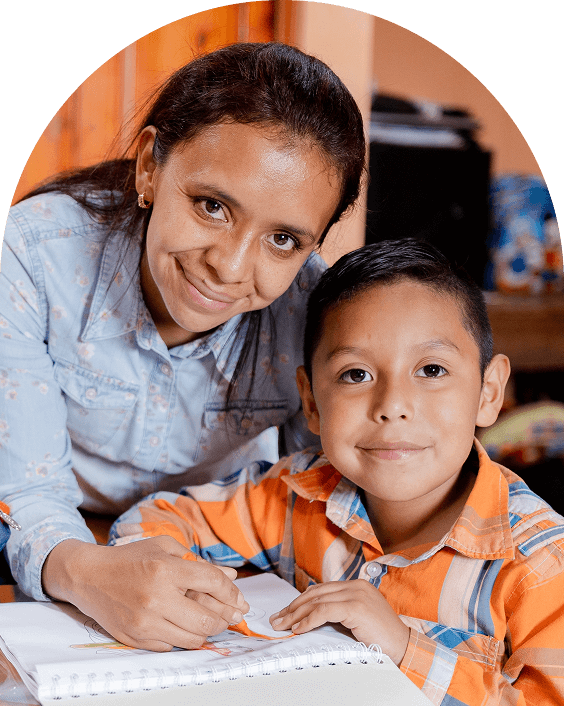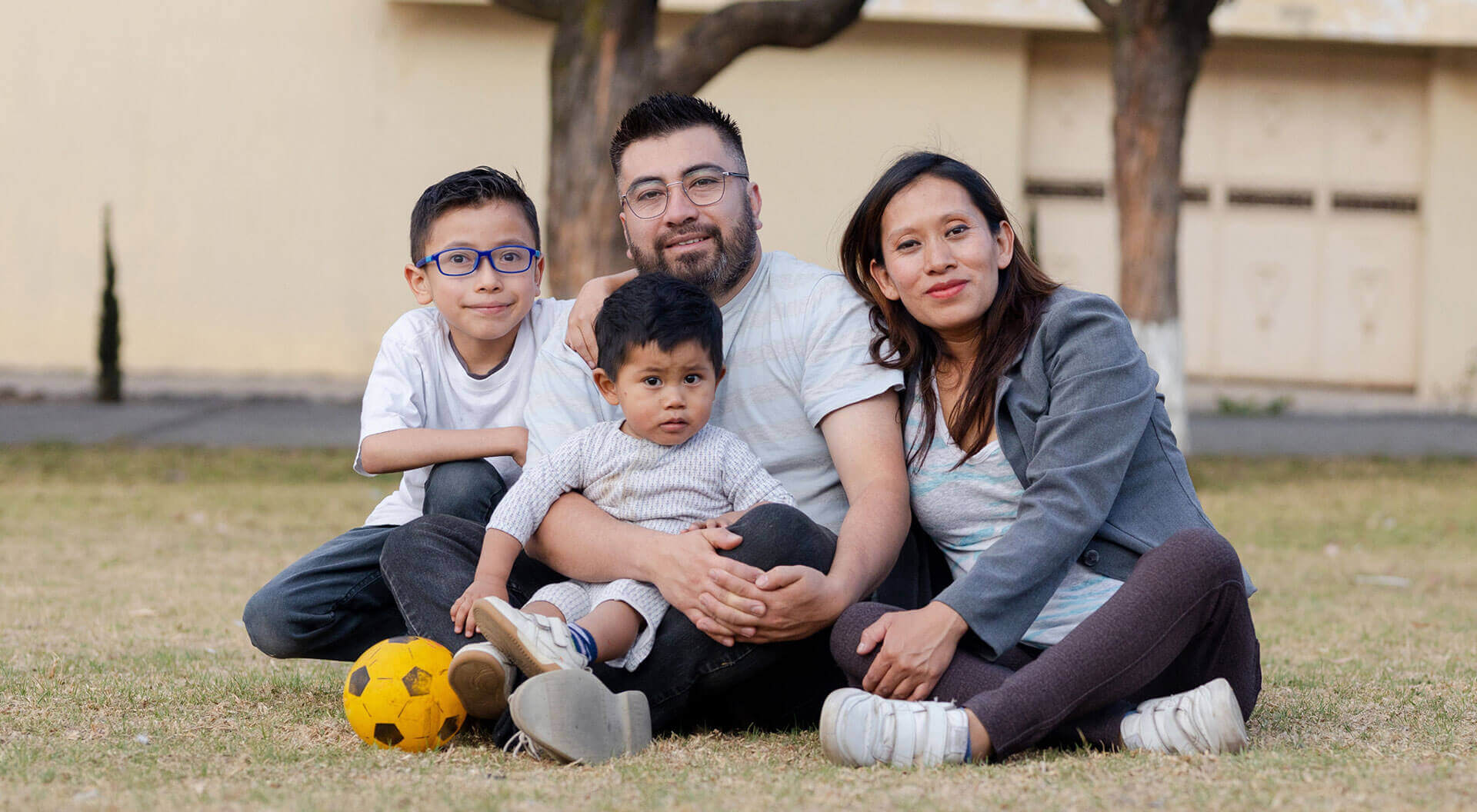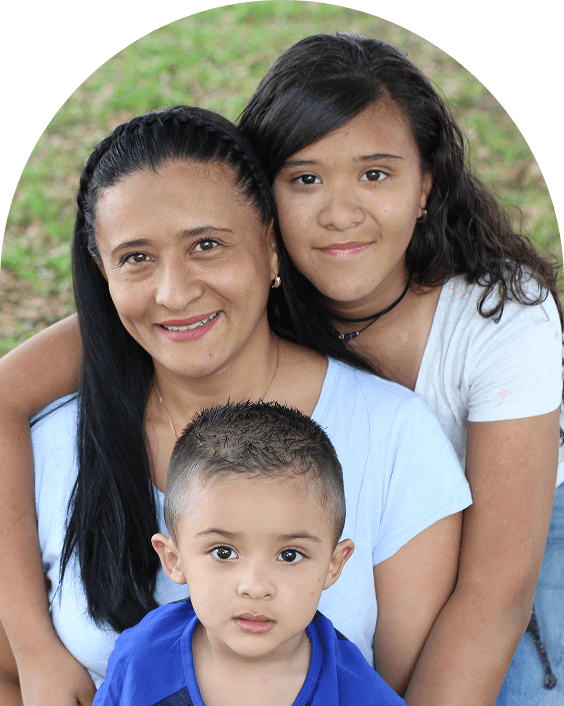
National
Latino Family
Report 2025
Aspiration in Uncertain Times
Introduction
For Latino families with young children, 2025 has been marked by political and economic uncertainty, ongoing financial stress, and doubt that President Donald Trump’s policies will positively impact families. In January and February, AP-OD, in conjunction with BSP Research and UnidosUS, surveyed nearly 1,400 Latino families across the United States. This report offers a snapshot of families’ hopes, worries, and visions for a stable and prosperous future for themselves and their children.
This year, perhaps unsurprisingly, Latino families with young children expressed increased urgency related to immigration policy. For the first time in our survey, respondents chose two immigration-related policies as among the most important for the president and Congress to address: protecting immigrant rights and providing a pathway to citizenship. Meanwhile, 57% of respondents said they worry their family members or friends will be detained or deported, and between 24% and 35% reported that the president's immigration policies might lead them to avoid seeking critical services and support, such as medical treatment, social services, and early-education programs for their children.

Top 6 issues Latino families want Congress and the president to address







The Latino community is an economic powerhouse in the United States, generating $3.6 trillion in gross domestic product in 2022 alone, an amount that, on its own, would rank as the fifth-largest economy in the world.[1] Still, the state of the U.S. economy was families’ most pressing concern this year. Nearly half of respondents — more than in any previous year — said their personal financial situation worsened in the past year, a sign that many families are struggling to keep up with the rising cost of living. Latino families continue to show strong support for social programs. Nine out of 10 respondents support paid family leave programs, and 87% support a $5,000 annual child tax credit, paid quarterly.
Despite economic uncertainty, our survey affirms that parents are showing up for their children, proving themselves resourceful in the face of rising costs, and finding support in family and community during a challenging time. They are borrowing from friends and family, seeking better-paying jobs, starting new businesses, and enrolling in courses to build new skills.
Eligible Hispanic voters comprise the second-largest — and second-fastest-growing — racial or ethnic voting bloc in the United States, with more than 36 million eligible voters. Latino voters are younger on average than their non-Hispanic white counterparts, and every year, about 1.4 million Latinos become eligible to vote.[2] These families represent the future of our country’s electorate, and it is critical that policymakers and elected officials understand their struggles, champion their proposed solutions, and engage them in the work of democracy.
Jump To...
Economic Well-Being


What impact do you think the president's economic policies will have on the U.S. economy?


What impact do you think the president's economic policies will have on your family’s finances?


Cheapflation

Renting Vs. Owning

Family Income

Over the past year, how has your personal financial situation changed?

Economic Resilience


How are you planning long-term for your child’s financial future?

37%
34%

Top five things families have done to adapt to rising costs:

47%
37%
31%
29%
24%

Ways families are working to improve their financial situation:

59%
43%
28%
20%
16%
Solutions


Would you support revising the Earned Income Tax Credit and Child Tax Credit so qualifying families receive $5,000 per child per year, paid quarterly?


Which one of the following family-oriented policies do you think is MOST important for the current administration to adopt?


Immigration


Do you worry that your friends or family members might be detained or deported due to their immigration status?

No two Latino families in the United States are the same. Family members trace their heritage to dozens of countries, and people living in the same household may have different immigration statuses. A 2024 report by the Pew Research Center estimated that 84% of children living with an undocumented immigrant parent were born in the United States. These children are U.S. citizens.[17] As deportation efforts ramped up during the first Trump administration, research suggested significant implications for the more than 12 million children of noncitizen parents. Pediatricians and caregivers reported that children’s fears led to trouble sleeping and eating, stomachaches, headaches, depression, anxiety, behavior changes, and reduced performance in school.[18] Our study suggests immigration-related anxiety is again widespread in 2025. Ultimately, society will bear the responsibility of helping these young people heal.
A significant number of survey respondents said they were hesitant to engage in activities that support healthy, safe, stable families and communities — a phenomenon known as “the chilling effect.” Thirty-seven percent of parents said they worried about making a medical appointment for their children, while 35% said they might avoid talking to police officers or reporting a crime. Nearly one-quarter of respondents said they might avoid going to work.
These behavioral trends can have ripple effects throughout society. In its 2018 report “Freezing Out Justice: How Immigration Arrests at Courthouses Are Undermining the Justice System,” the American Civil Liberties Union found that more than half of judges surveyed said court cases had been interrupted because an immigrant crime survivor was afraid to come to court. And 67% of police officers reported a negative impact on their ability to protect crime survivors.[19]

When making a medical appointment for your child, how concerned are you about immigration or immigration status?


Which of the following activities might you avoid due to the current administration's mass deportation plans?

35%
32%
30%
27%
26%
25%
24%
Our survey suggests the chilling effect may hinder Latino children’s educational development. Nearly one-third of Latino parents and primary caregivers reported they may avoid signing up their children for early-childhood and school programs, and 26% said they might avoid talking to school officials or teachers. This shift in parental behavior could have consequences that outlive the president's time in office.
Nevertheless, Latinos’ views on immigration remain complex. Surveyed families indicated that protecting immigrant rights and providing a path to citizenship are among their top policy priorities. Another top priority? Reducing gun violence and mass shootings. Latino parents want their children to grow up in safe, supportive communities. That may be why they also indicated broad support for border enforcement and the deportation of undocumented immigrants who have been convicted of crimes.

How important is it for Congress and the President to address the following policy issues?

86%
80%

Solutions


Do you support or oppose the following policies?

73%
support
A bipartisan immigration reform bill
78%
support
Protections for DACA recipients
69%
oppose
Mass deportations of immigrants
[20] The New York Times
[21] AP News

Do you agree or disagree with the current administration's policy that allows immigration raids in places like churches and schools?


Should your state cooperate with the current administration's mass deportation policies?

Early Education & Child Care


Top 3 issues the government should address to improve child well-being




Most important considerations when evaluating child care options:

97%
96%
Affordability
Fair wages for teachers
Convenient location
Flexible schedule
Well-trained educators
Child Care Affordability

Child care costs are not immune to inflation, and prices for care in the United States have increased significantly since before the COVID-19 pandemic. According to a Center for American Progress report, the annual cost for two children in center-based care increased by about $1,000 between 2016 and 2023, even after adjusting for inflation.[22] This year, 53% of survey respondents said their youngest child had received child care outside the home, compared to 59% in the general population. [23] Among respondents whose children had not received care outside the home, 32% cite prohibitive cost as a primary reason.
The U.S. Department of Health and Human Services’ (HHS) benchmark for affordable child care is 7% of a family’s income. But this year, 39% of respondents said they spend between 11% and 25% of their take-home pay on child care. Another 17% spend between 26% and 50% of their income — a potentially debilitating financial burden that far exceeds the federal benchmark.

How much do you spend on child care each month, as a percentage of your monthly income?


Which of the following child care challenges have you experienced in the past year?


Top five reasons parents choose not to send their children to child care facilities:

Culture and Bilingualism in Education

In March, President Trump issued an executive order establishing English as the official language of the United States and rescinding a federal policy that required agencies to provide information in multiple languages. Immigrant rights advocates feared the move would fuel discrimination and make it more difficult for non-English speakers to vote and to access critical federal benefits.
Two weeks later, the administration announced the firing of half the staff at the Department of Education, including nearly all employees in the Office of English Language Acquisition (OELA).[24] As its name implies, the OELA ensures the proper spending of money earmarked to help students learn English. It remains unclear whether the office will continue to exist in any capacity after its gutting.
There are 5.3 million English learners in U.S. schools,[25] and 76% of them speak Spanish. Public schools are required by federal law to ensure these students have access to high-quality education. For many parents queried in our survey, that means enrolling their kids in bilingual programs.
Nearly 40% of survey respondents said their children attended bilingual, dual-language, or immersion programs. Latino families expressed deep pride in their language and culture, and they indicated strong support for bilingualism and bilingual education. Eighty-eight percent of participants reported they want their children to be bilingual, and 92% said child care facilities should offer multilingual and multicultural education.


Do you want your child to be bilingual in English and Spanish?


Does your child attend a bilingual, language immersion, or dual-language program?


If not, why?

Solutions

When it comes to caring for their young children, Latino families are unequivocal: They are advocating for high-quality, affordable child care programs that pay fair wages to staff and celebrate Latino culture and language in the classroom.
A young child’s brain develops at an astounding rate early in life — and families understand it is critical to give their children a strong start. They know smart government programs can help them get there. Our survey respondents indicated overwhelming support for social safety nets that help young families learn and grow together. Nearly three-quarters of families oppose eliminating Head Start programs, and 91% support state-run paid family leave programs that allow parents to care for their newborns and newly adopted children without enduring the stress and uncertainty of unpaid time off work. This support remained strong even when respondents learned that employees would have to pay a few dollars each week to fund the program.

Respondents indicated strong support for paid family leave:

91%
81%
Conclusion

This survey is a snapshot of an enterprising, resilient, growing community working hard to raise the next generation amid economic challenges and political unrest. Latino families with young children contribute their entrepreneurial spirit, bilingualism, and optimism to their communities, and they understand what they need to thrive.
Families are advocating for continued and expanded access to social safety net programs, bipartisan immigration reform, and common-sense investments in the education and care of young children. Policymakers would do well to consider the insights and creative solutions coming from this robust community.
About This Report
Survey Methodology
Acknowledgments
Parents:
Carmen Adriana Lopez
Hector Aveldaño
Mariela Garcia & Eduardo Maldonado



